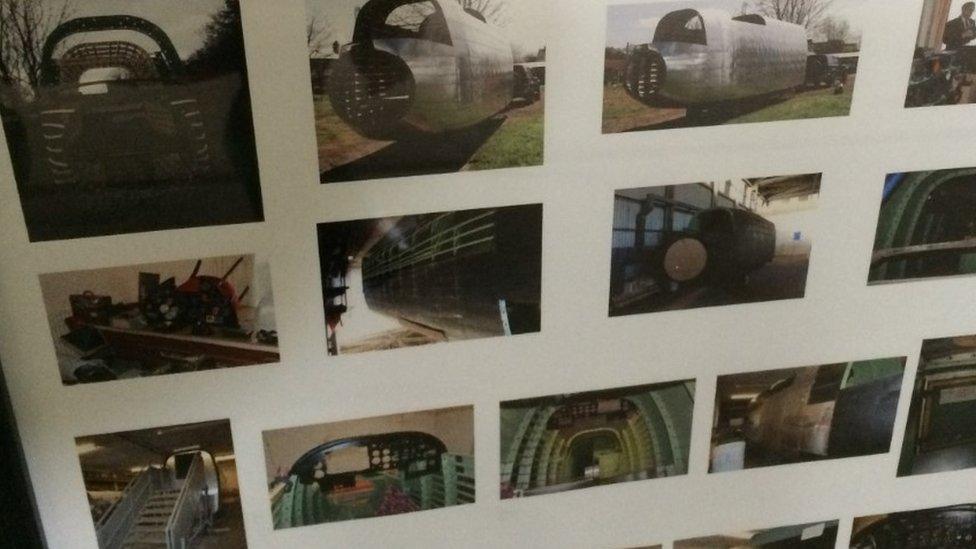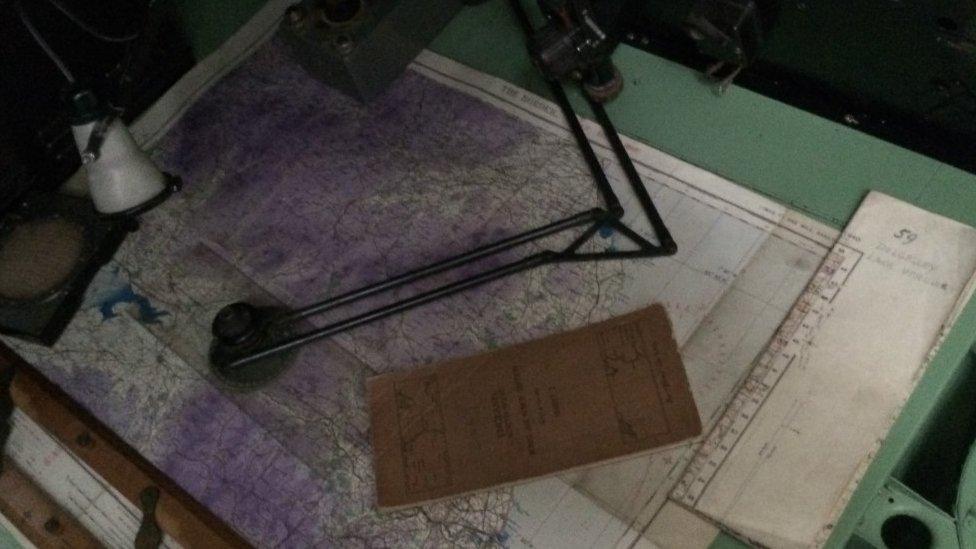RAF Waddington S-Sugar bomber fuselage replica unveiled
- Published

The replica features a quote from Goering which is recreated as it appeared on the original S-Sugar bomber, complete with wrong spelling of Hermann
An ex-serviceman has created part of a replica Lancaster bomber based on the original aircraft restored by his father.
Martin Willoughby has spent eight years building part of a fuselage modelled on the Lancaster R5868, S-Sugar.
The aircraft, which flew from RAF Waddington in Lincolnshire, was the first Allied bomber to complete 100 missions during World War Two.
Mr Willoughby said he wanted to use it to provide an "interactive experience".
He plans to take it into schools to let children experience life in the cockpit.

The replica was put together at an airfield hangar near Grimsby
Mr Willoughby, from Grimsby, came up with the idea after helping his late father Ted Willoughby, who served as a fitter in the war, with the restoration of the original S-Sugar.
"Other kids had Airfix, I had the real thing," he said.

Mr Willoughby said he has spent hundreds of thousands of pounds on the project
Mr Willoughby, who is chairman of 463/467 Lancaster RAAF Squadrons, external, which crewed the aircraft at RAF Waddington, unveiled it at the Lincolnshire base on Monday to coincide with Anzac Day.
"All the crew stations have authentic Lancaster equipment, collected over all these years from places as far away as Australia, Canada and the US," he said.
"What you can see now is a hybrid of fabrication and real Lancaster materials.

It has genuine parts sourced from all over the world, including authentic dials, radios, guns, compasses and maps
He said the cost of the project "must be in the hundreds of thousands".
"The real truth is I don't know how much I have spent on it - I've just continued ploughing money in," he said.
Mr Willoughby, who was diagnosed with Leukaemia midway through the project, added: "On a few occasions I was ready to give up - but with support from my family - we are where we are today."
He now intends to transform the replica into a fully working flight simulator, with wrap-around screens and interactive controls.

A potted history of Lancaster R5868, S-Sugar

The crew marked the S-Sugar completing 100 operations
Lancaster bomber R5868, S-Sugar flew a total of 137 operations during World War Two although some dispute the figure was quite this high
On average, Lancasters completed just 21 missions before being lost. S-Sugar was the first Allied Bomber to complete 100 operations
The bomber started life at RAF Scampton, moving to a number of other bases, before moving to RAF Waddington in November 1943
Air gunner Steve G.W. Bethell, who flew on the aircraft later wrote that Sugar was affectionately thought to be capable of finding its own way back from any target in Europe, but a navigator was carried just in case
The crew had a narrow escape during the aircraft's 96th mission, a bombing raid on Berlin - but rather than sustaining damage from enemy fire, the aircraft collided with another Lancaster at 20,000 feet over the target area
In 1960, the bomber was placed on display at the main gate of RAF Scampton in No 467 Squadron markings
After being re-discovered in 1969 and restored by its wartime fitter Ted Willoughby, a ceremony marking completion of internal work took place in 1973
Source RAF Museum

- Published27 September 2013
